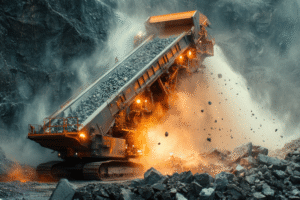Lynas Revisited: Can It Reclaim Its Crown in Rare Earths?
![]() Ujjwal Maheshwari, October 1, 2025
Ujjwal Maheshwari, October 1, 2025
After more than a decade as one of the leading non-Chinese rare earths producers, Lynas Rare Earths (ASX: LYC) now finds itself at a critical juncture. Investors have long seen Lynas as the flagship name in critical minerals Australia, a rare example of a successful non-Chinese producer of rare earth oxides. But the competitive landscape has shifted: new juniors are emerging, China continues to undercut rivals, and geopolitical tensions are rewriting supply chains. The question for investors in 2025 is simple: can Lynas still lead the charge, or is its crown slipping away? The company still offers scale and credibility that newcomers lack, but execution and cost pressures will determine whether it reasserts leadership or fades into the background.
What are the Best Asx stocks to invest in right now?
Check our buy/sell tips
Lynas: Background & Competitive Position
Lynas is a veteran in the rare earths market and one of the few players outside China with genuine scale. Its business model is vertically integrated, beginning at the Mt Weld mine in Western Australia, a deposit long regarded as one of the richest rare earth ore bodies globally. From Mt Weld, the company ships concentrated ore to its Lynas Advanced Materials Plant (LAMP) in Malaysia, where separation and processing take place. This setup allows Lynas to produce a range of refined products, particularly neodymium (Nd) and praseodymium (Pr), which are critical ingredients in high-strength permanent magnets used across electric vehicles, wind turbines, and defence technologies.
The company’s historical role in the global supply chain has been pivotal. At a time when China dominates rare earths with around 80–90% of mining and close to 90% of refining capacity, Lynas has been the standout non-Chinese producer, supplying Japanese manufacturers and other Western partners. This credibility has helped it secure long-term offtake agreements and position itself as a “strategic” supplier in an increasingly politicised market. Unlike many juniors who aspire to enter the space, Lynas already has the infrastructure, customer relationships, and experience to compete at scale. That said, its product mix has leaned heavily toward light rare earths, leaving it exposed to pricing volatility. The real prize, investors know, lies in heavy rare earths such as dysprosium and terbium, and Lynas is finally taking steps to close that gap.
Recent Updates & Strategic Moves
The most notable development in 2025 has been Lynas’s breakthrough into heavy rare earths. In May, the company announced its first production of dysprosium oxide, followed by terbium oxide in June at its Malaysian facility, marking the beginning of commercial-scale heavy rare earth separation. This milestone makes Lynas, by its own and industry accounts, the only commercial-scale producer of separated heavy rare earths outside China as of 2025, giving it a new revenue stream and a chance to capture higher-margin opportunities. These heavy rare earths are indispensable for advanced magnet applications in EVs and defence, making Lynas’ achievement strategically significant. Investors who have long questioned whether Lynas could move up the value chain now have a tangible answer.
On the supply side, Lynas has also struck a memorandum of understanding with Malaysia’s Kelantan state investment arm to secure feedstock from future ionic-clay projects. While still non-binding, this shows a clear intent to embed more of the supply chain in Malaysia, reducing transport costs and aligning more closely with host-country stakeholders. This could improve social licence at a time when regulatory risk in Malaysia remains high.
Financially, the picture is more mixed. Lynas raised A$750 million in August 2025 to fund expansion, but its net profit plunged to just A$8 million in FY25, compared with A$84.5 million the previous year. This sharp fall highlights how growth projects and cost pressures are weighing heavily on earnings. For investors, it’s a reminder that Lynas is still very much in a build-out phase, where capital-intensive projects and execution risks dominate. Nevertheless, NdPr oxide output has reached record levels in recent quarters, with production of around 1,500 tonnes, showing that operationally, the company is capable of scaling.
Regulatory risk remains in focus. Malaysia extended Lynas’ licence to import radioactive material until March 2026, with conditions requiring the management of radioactive waste. Future extensions will likely depend on regulatory compliance and political support, underscoring how environmental factors continue to weigh on the investment case.
Competition & New Players
The rare earths sector has seen a rush of new entrants in recent years. From ionic-clay explorers in Africa to Australian juniors promising cutting-edge separation technologies, the sector is crowded with stories of potential disruption. Yet for all the excitement, very few of these new names have advanced beyond the exploration or pilot-plant phase. Building processing facilities, securing regulatory approvals, and winning customer trust remain formidable barriers to entry. Investors who recall the 2010–2012 rare earths boom will remember that many juniors failed to deliver on their grand promises.
Against this backdrop, Lynas continues to hold key advantages. It has scale, with established facilities already delivering thousands of tonnes of product each quarter. It has deep customer relationships, particularly in Japan, where buyers value reliability and consistency over unproven promises. Most importantly, Lynas is no longer just a light rare earths story: with the addition of heavy rare earth separation, it has positioned itself in a higher-value part of the supply chain. While some juniors may talk of disrupting the market, Lynas is already producing, and that distinction matters.
For investors comparing Lynas vs new rare earth plays, the decision often boils down to risk appetite. Lynas may offer slower upside but carries lower execution risk. Juniors, on the other hand, offer blue-sky potential but come with a high likelihood of delays, cost overruns, or outright failure.
Risks & Headwinds
No discussion of Lynas is complete without acknowledging the risks. Malaysia remains a perennial source of uncertainty. While the current licence runs to 2026, public opposition to Lynas’ operations has flared repeatedly in the past. A regulatory crackdown could force the company to shift more processing back to Australia, at significant cost. Investors should keep a close eye on political developments in Malaysia as a leading indicator of risk.
Competition from China is another ongoing threat. China can flood the market with cheap supply, undermining prices for NdPr and heavy rare earths. Even with geopolitical tailwinds favouring diversification, the sheer scale and flexibility of Chinese producers remain daunting. A prolonged price war could test Lynas’ margins.
Cost inflation is also a concern. Lynas is investing heavily in its Kalgoorlie facility, upgrades in Malaysia, and the proposed Seadrift project in Texas, which is still under development. The company itself has flagged uncertainty about the Texas project, noting that its progress may depend on U.S. government support or offtake agreements. These capital-intensive ventures increase debt and depreciation charges, while rising labour and energy costs add further strain. Project execution risk is high, and any delays could spook investors. Finally, broader commodity cyclicality looms: if EV adoption slows or global growth falters, demand for rare earths could soften, undermining the bullish narrative.
Outlook & Catalysts
Despite the risks, Lynas has a credible growth story that could drive upside if execution improves. The ramp-up of heavy rare earth separation is perhaps the single most important catalyst. If Lynas can scale its heavy rare earth output to the designed capacity of about 1,500 tonnes per year and consistently produce terbium and dysprosium, it will strengthen its claim as a global leader in rare earths. Securing long-term offtake agreements with automakers or defence companies would further de-risk revenues and likely trigger a market re-rating.
Investors should also watch the progress of the U.S. Seadrift project. If Lynas can bring this online with U.S. government support, it would provide exposure to a major market desperate to reduce reliance on Chinese supply. Similarly, partnerships downstream, such as into magnet production, could capture more margin. Combined with supportive policy moves from Australia, Japan, and the U.S., these catalysts could transform Lynas’ valuation profile. Ultimately, much depends on the price trajectory of NdPr, dysprosium, and terbium. A strong pricing cycle would help Lynas absorb higher costs and fund its expansion, while weak prices could derail even the most ambitious plans.
Lynas Share Price & Growth Outlook
The Lynas share price 2025 has been volatile, swinging on news of equity raisings, production milestones, and regulatory developments. Analysts are divided: some see upside based on growth forecasts through 2026, while others caution that profits remain under pressure from high capital expenditure. The truth likely lies somewhere in between. Investors should expect volatility, but also recognise that Lynas remains the best-positioned non-Chinese producer in the sector.
The Lynas growth outlook to 2028 is cautiously optimistic. With NdPr production rising, heavy rare earth separation underway, and potential U.S. expansion, Lynas has multiple levers for growth. But the company must execute flawlessly and navigate risks to deliver shareholder value. For long-term investors, Lynas offers exposure to the rare earths theme with less downside risk than junior explorers, but also less explosive upside.
Investor Takeaway
So, can Lynas reclaim its crown in rare earths? The company remains the cornerstone of critical minerals Australia, with advantages in scale, infrastructure, and relationships that no junior can easily replicate. The step into heavy rare earth separation is a turning point that cements its status as more than just a light rare earths producer. But the path ahead is not without hurdles: regulatory risk in Malaysia, competition from China, and the burden of capital expansion all weigh heavily on the outlook.
For investors, Lynas offers a balanced exposure. It may not deliver the spectacular gains of speculative juniors, but it provides stability and strategic value in a sector where reliability is scarce. A core holding in Lynas, supplemented by selective exposure to juniors for upside, may be the most effective strategy. If Lynas executes on its heavy rare earth ambitions and secures strategic partnerships, the crown may not only be retained but burnished.
FAQs
- What is driving the Lynas share price in 2025?
The Lynas share price 2025 has been influenced by several factors, including the successful launch of heavy rare earth separation in Malaysia, near-record NdPr production, and the A$750 million equity raising. At the same time, weaker net profits and cost pressures have created volatility. Investors should expect swings as the market weighs long-term growth against near-term execution risks.
- How does Lynas compare to new rare earth plays on the ASX?
When weighing Lynas vs new rare earth plays, scale and credibility stand out. Lynas already produces thousands of tonnes of rare earth oxides each quarter, with established customer relationships in Japan and the U.S. By contrast, most juniors are still in exploration or pilot phases. While juniors may offer high-risk, high-reward upside, Lynas provides stability and remains the only large-scale non-Chinese producer.
- What are the biggest risks for Lynas going forward?
Lynas faces four main risks: regulatory pressure in Malaysia over its LAMP facility, cost blowouts from its Kalgoorlie and U.S. projects, competition from China undercutting prices, and the cyclical nature of rare earth markets. Investors must also factor in environmental and ESG obligations, which are increasingly scrutinised in the critical minerals sector.
- Does Lynas have a strong growth outlook?
Yes, the Lynas growth outlook is positive, particularly with its expansion into heavy rare earth separation. If the company can scale production of dysprosium and terbium, secure long-term offtake deals, and progress its U.S. facility, it could cement its role as a global leader. However, profitability will depend on rare earth prices and disciplined project execution.
- Is Lynas still a good investment in critical minerals Australia?
In our view, Lynas remains one of the most reliable ways to gain exposure to critical minerals in Australia. Its combination of scale, infrastructure, and strategic positioning makes it an anchor holding for investors who want stability in rare earths. That said, investors looking for explosive returns may also consider small-cap rare earth explorers, but these carry much higher risk.
Blog Categories
Get Our Top 5 ASX Stocks for FY26
Recent Posts
Renerve secures A$3.2M to accelerate commercialisation of its nerve repair devices
ReNerve (ASX: RNV) saw a sharp move this month, first surging 66% in a single session to a gain of…
Larvotto Resources is fully funded for its $694M Hillgrove Project
18% Jump for Larvotto Resources as Hillgrove Construction Moves Ahead, Backed by $175M in New Funding Larvotto Resources (ASX: LRV)…
Archer Materials Cracks Quantum Readout Challenge as Stock Surges 12%
Archer Materials Just Solved One of Quantum Computing’s Hardest Problems Archer Materials (ASX: AXE) jumped 12% today after unveiling two…



